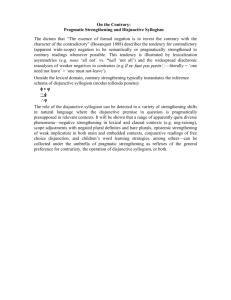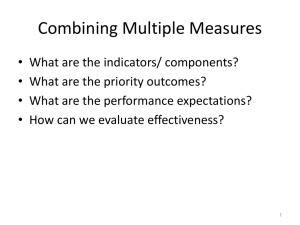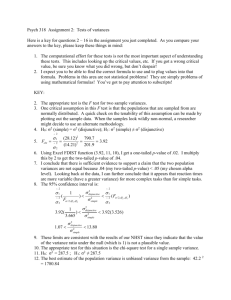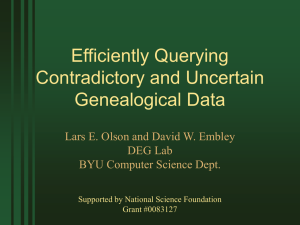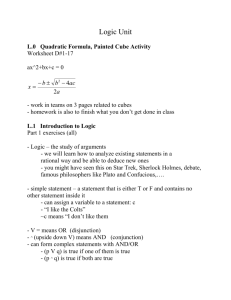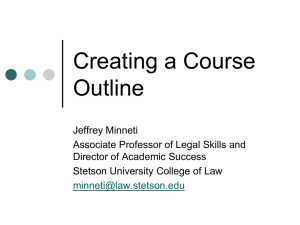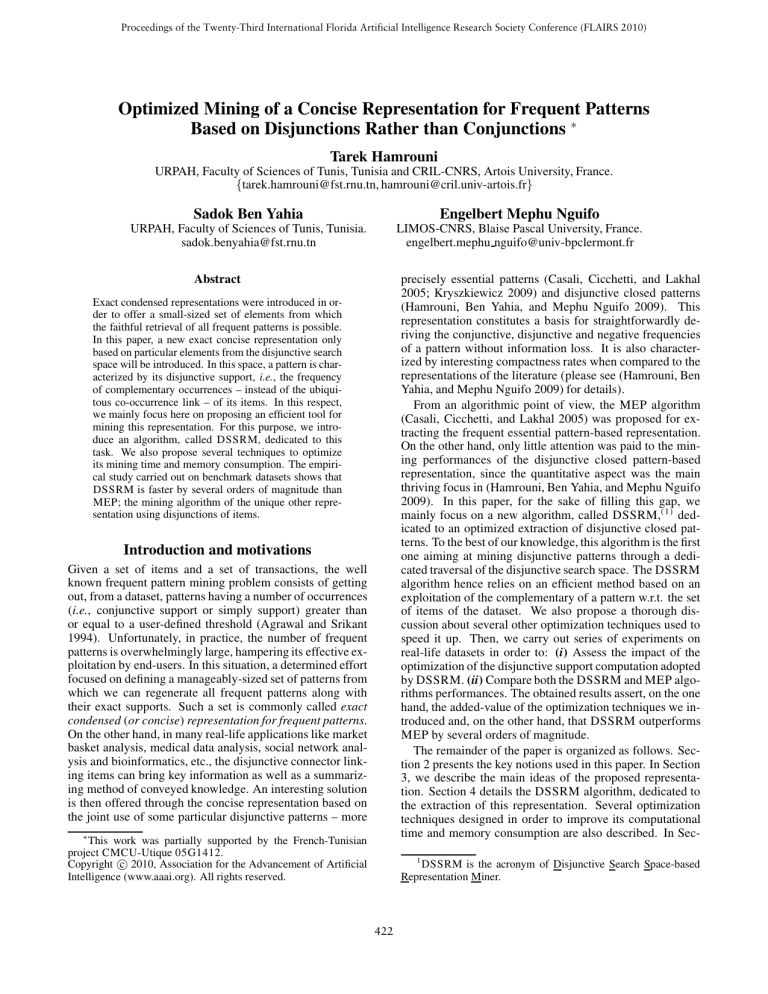
Proceedings of the Twenty-Third International Florida Artificial Intelligence Research Society Conference (FLAIRS 2010)
Optimized Mining of a Concise Representation for Frequent Patterns
Based on Disjunctions Rather than Conjunctions ∗
Tarek Hamrouni
URPAH, Faculty of Sciences of Tunis, Tunisia and CRIL-CNRS, Artois University, France.
{tarek.hamrouni@fst.rnu.tn, hamrouni@cril.univ-artois.fr}
Sadok Ben Yahia
Engelbert Mephu Nguifo
URPAH, Faculty of Sciences of Tunis, Tunisia.
sadok.benyahia@fst.rnu.tn
LIMOS-CNRS, Blaise Pascal University, France.
engelbert.mephu nguifo@univ-bpclermont.fr
precisely essential patterns (Casali, Cicchetti, and Lakhal
2005; Kryszkiewicz 2009) and disjunctive closed patterns
(Hamrouni, Ben Yahia, and Mephu Nguifo 2009). This
representation constitutes a basis for straightforwardly deriving the conjunctive, disjunctive and negative frequencies
of a pattern without information loss. It is also characterized by interesting compactness rates when compared to the
representations of the literature (please see (Hamrouni, Ben
Yahia, and Mephu Nguifo 2009) for details).
From an algorithmic point of view, the MEP algorithm
(Casali, Cicchetti, and Lakhal 2005) was proposed for extracting the frequent essential pattern-based representation.
On the other hand, only little attention was paid to the mining performances of the disjunctive closed pattern-based
representation, since the quantitative aspect was the main
thriving focus in (Hamrouni, Ben Yahia, and Mephu Nguifo
2009). In this paper, for the sake of filling this gap, we
mainly focus on a new algorithm, called DSSRM,( 1) dedicated to an optimized extraction of disjunctive closed patterns. To the best of our knowledge, this algorithm is the first
one aiming at mining disjunctive patterns through a dedicated traversal of the disjunctive search space. The DSSRM
algorithm hence relies on an efficient method based on an
exploitation of the complementary of a pattern w.r.t. the set
of items of the dataset. We also propose a thorough discussion about several other optimization techniques used to
speed it up. Then, we carry out series of experiments on
real-life datasets in order to: (i) Assess the impact of the
optimization of the disjunctive support computation adopted
by DSSRM. (ii) Compare both the DSSRM and MEP algorithms performances. The obtained results assert, on the one
hand, the added-value of the optimization techniques we introduced and, on the other hand, that DSSRM outperforms
MEP by several orders of magnitude.
The remainder of the paper is organized as follows. Section 2 presents the key notions used in this paper. In Section
3, we describe the main ideas of the proposed representation. Section 4 details the DSSRM algorithm, dedicated to
the extraction of this representation. Several optimization
techniques designed in order to improve its computational
time and memory consumption are also described. In Sec-
Abstract
Exact condensed representations were introduced in order to offer a small-sized set of elements from which
the faithful retrieval of all frequent patterns is possible.
In this paper, a new exact concise representation only
based on particular elements from the disjunctive search
space will be introduced. In this space, a pattern is characterized by its disjunctive support, i.e., the frequency
of complementary occurrences – instead of the ubiquitous co-occurrence link – of its items. In this respect,
we mainly focus here on proposing an efficient tool for
mining this representation. For this purpose, we introduce an algorithm, called DSSRM, dedicated to this
task. We also propose several techniques to optimize
its mining time and memory consumption. The empirical study carried out on benchmark datasets shows that
DSSRM is faster by several orders of magnitude than
MEP; the mining algorithm of the unique other representation using disjunctions of items.
Introduction and motivations
Given a set of items and a set of transactions, the well
known frequent pattern mining problem consists of getting
out, from a dataset, patterns having a number of occurrences
(i.e., conjunctive support or simply support) greater than
or equal to a user-defined threshold (Agrawal and Srikant
1994). Unfortunately, in practice, the number of frequent
patterns is overwhelmingly large, hampering its effective exploitation by end-users. In this situation, a determined effort
focused on defining a manageably-sized set of patterns from
which we can regenerate all frequent patterns along with
their exact supports. Such a set is commonly called exact
condensed (or concise) representation for frequent patterns.
On the other hand, in many real-life applications like market
basket analysis, medical data analysis, social network analysis and bioinformatics, etc., the disjunctive connector linking items can bring key information as well as a summarizing method of conveyed knowledge. An interesting solution
is then offered through the concise representation based on
the joint use of some particular disjunctive patterns – more
∗
This work was partially supported by the French-Tunisian
project CMCU-Utique 05G1412.
c 2010, Association for the Advancement of Artificial
Copyright Intelligence (www.aaai.org). All rights reserved.
1
DSSRM is the acronym of Disjunctive Search Space-based
Representation Miner.
422
Example. Consider our running dataset. For minsupp = 2,
AC is a frequent essential pattern. Indeed, AC is a frequent
pattern since Supp(AC) = 3 ≥ minsupp. Moreover, AC is
an essential pattern since Supp(∨AC) = 5 is strictly greater
than max{Supp( ∨ A), Supp( ∨ C)}, equal to 4.
We denote by F P (resp. F EP ) the set of frequent patterns (resp. frequent essential patterns). In (Casali, Cicchetti, and Lakhal 2005), it was proved that F EP is downward closed. Indeed, if I is a frequent essential pattern then
all its subsets are also frequent essential ones. To ensure
the exact regeneration process of frequent patterns, the authors of (Casali, Cicchetti, and Lakhal 2005) proposed to
augment this set by maximal frequent patterns. This obliges
the associated mining algorithm, namely MEP (Casali, Cicchetti, and Lakhal 2005), to bear the cost of exploring both
disjunctive and conjunctive search spaces to mine both sets
composing the representation. Indeed, essential patterns and
maximal frequent patterns are respectively characterized by
different kinds of supports: disjunctive for the former and
conjunctive support for the latter. The MEP algorithm thus
relies on a dedicated algorithm for exploring the conjunctive
search space through the invocation of an external algorithm
for mining maximal frequent patterns.
tion 5, an experimental study shows the utility of the proposed approach. Section 6 concludes the paper and points
out our future work.
Key notions
In this section, we briefly present the key notions that will
be of use throughout the paper.
Definition 1 (Dataset) A dataset is a triplet D = (T , I, R)
where T and I are, respectively, a finite set of transactions
and items, and R ⊆ T × I is a binary relation between the
transactions and items. A couple (t,i) ∈ R denotes that the
transaction t ∈ T contains the item i ∈ I.
Example. We will consider in the remainder an example dataset D composed by the set of transactions T =
{(1, ABCD), (2, ACDE), (3, ACEF), (4, ABDEF), (5,
BCDF)}.( 2)
The following definition presents the different types of
supports that can be assigned to a pattern.
Definition 2 (Supports of a pattern) Let D = (T , I, R) be
a dataset and I be a pattern. We mainly distinguish three
kinds of supports related to I:
Supp(I )
Supp( ∨ I )
=
=
| {t ∈ T | (∀ i ∈ I, (t, i) ∈ R)} |
| {t ∈ T | (∃ i ∈ I, (t, i) ∈ R)} |
Supp(I )
=
| {t ∈ T | (∀ i ∈ I, (t, i) ∈
/ R)} |
Disjunctive closed patterns
Structural properties
Given an arbitrary pattern, its disjunctive closure is equal to
the maximal pattern, w.r.t. set inclusion, containing it and
having the same disjunctive support. The following definition formally introduces the disjunctive closure.
Definition 5 (Disjunctive closure of a pattern) The disjunctive closure of a pattern I is: h(I ) = max ⊆ {I1 ⊆ I |
(I ⊆ I1 ) ∧ (Supp( ∨ I ) = Supp( ∨ I1 ))} = I ∪ {i ∈ I\I|
Supp(∨ I ) = Supp(∨ (I ∪ {i}))}.
Example. Consider our running dataset. We have h(D) =
BD. Indeed, BD is the maximal pattern containing D and
having a disjunctive support equal to that of D.
The closure operator h induces an equivalence relation
on the power-set of I, which partitions it into disjoint subsets called disjunctive equivalence classes. The elements of
each class have the same disjunctive closure and the same
disjunctive support. The essential patterns of a disjunctive
equivalence class are the smallest incomparable members,
w.r.t. set inclusion, while the disjunctive closed pattern is
the largest one.
Example. Supp(BC) = | {1, 5} | = 2, Supp( ∨ BC) =
|{1, 2, 3, 4, 5}| = 5 and Supp(BC) = 0.
In the remainder, if there is no risk of confusion, the conjunctive support will simply be called support. Having the
disjunctive supports of patterns subsets, we can derive their
conjunctive supports using an inclusion-exclusion identity
(Galambos and Simonelli 2000), while their negative supports are derived thanks to the De Morgan law, as follows:
Lemma 3 (Relations between the supports of a pattern)
Let I be a pattern. The following equalities hold:
(-1)|I1 |−1 Supp( ∨ I1 )
(1)
Supp(I ) =
∅⊂I1 ⊆I
Supp(I )
= | T | − Supp( ∨ I )
(2)
Example. Given the respective disjunctive supports of BC’
subsets, its conjunctive and negative supports are inferred
as follows:
• Supp(BC) = (-1)|BC| − 1 Supp(∨BC) + (-1)|B| − 1
Supp(∨B) + (-1)|C| − 1 Supp(∨C) = - Supp(∨BC) +
Supp(∨B) + Supp(∨C) = - 5 + 3 + 4 = 2.
• Supp(BC) = |T | - Supp(∨BC) = 5 - 5 = 0.
A frequent (essential) pattern is defined as follows.
Disjunctive closed pattern-based representation
Definition 4 (Frequent, Essential, Frequent essential pattern) For a user-defined minimum support threshold minsupp, a pattern I is frequent if Supp(I ) ≥ minsupp. I is said
to be essential if Supp(∨I ) > max{Supp( ∨ I\{i}) | i ∈ I}
(Casali, Cicchetti, and Lakhal 2005). I is a frequent essential pattern if it is simultaneously frequent and essential.
Our representation relies on the set defined as follows:
Definition 6 The set EDCP (3) gathers the disjunctive closures of frequent essential patterns: EDCP = {h(I ) | I ∈
F EP}.
An interesting solution ensuring the exactness of the representation based on the disjunctive closed patterns of EDCP
consists in adding the set F EP of frequent essential patterns. This is stated by the following theorem.
2
We use a separator-free form for the sets, e.g., ABCD stands
for the set of items {A, B, C, D}.
3
EDCP is the acronym of Essential Disjunctive Closed
Patterns.
423
Theorem 7 The set EDCP ∪ F EP of disjunctive patterns,
associated to their respective disjunctive supports, is an exact representation of the set of frequent patterns F P.
disjunctive closures of equal-size patterns can be performed
using a unique pass over the dataset.
According to Definition 5, a naive method for obtaining
the closure of I is to augment it by the items maintaining
its support unchanged. However, this requires knowing beforehand the disjunctive support of (I ∪ {i}) for each item
i ∈ I\I, what can be very costly. Hence, we propose in
the following an efficient method for computing closures.
The computation of the disjunctive closures of equal-size
patterns can thus be done in a one pass over the dataset using
the following lemma.
Proof. Let I ⊆ I. If there is a pattern I1 s.t. I1 ∈ F EP
and I1 ⊆ I ⊆ h(I1 ), then h(I ) = h(I1 ) since h is isotone as
being a closure operator. Hence, Supp(∨ I ) = Supp(∨ I1 ).
Since the disjunctive support of I is correctly derived, then
its conjunctive support can be exactly computed thanks to
Lemma 3, and then compared to minsupp in order to retrieve
its frequency status. If there is not such a pattern I1 , then I
is necessarily encompassed between an infrequent essential
pattern and its closure. Consequently, I is infrequent since
the frequency is an anti-monotone constraint (Agrawal and
Srikant 1994).
The proof of Theorem 7 can also easily be transformed to
a naive algorithm for deriving frequent patterns and their
associated supports starting from this representation. This
can straightforwardly be done in a levelwise manner that regenerates 1-frequent patterns, 2-frequent patterns, and so
forth. The DSSR representation ensures the easy derivation of the disjunctive support of each frequent pattern, and
hence its negative one using the De Morgan law as well as its
conjunctive support through only to evaluation of a unique
inclusion-exclusion identity. Another important feature of
this representation is the fact that it is homogeneous in the
sense that it is only composed by disjunctive patterns. It
hence requires only traversing the disjunctive search space
while offering the direct retrieval of the different types of
supports of frequent patterns. This representation hence
avoids the exploration of the conjunctive search space since
it does not need to add supplementary information from the
conjunctive search space to check whether a pattern is frequent or not. Since this representation is composed by particular elements within the disjunctive search space, namely
essential and disjunctive closed patterns, it will be denoted
DSSR which stands for Disjunctive Search Space-based
Representation. Another interesting feature of the DSSR
representation is that it can be stored in a very compact way
and without information loss. This is carried out as follows:
DSSR = {(e, f \e, Supp(∨ e)) | e ∈ F EP and f = h(e) ∈
EDCP}. Note that f \e is the difference between f and e.
Each disjunctive closed pattern, like f , is then simply derivable by getting the union between e and f \e.
Lemma 8 (Structural characterization of the disjunctive
closure) The disjunctive closure h(I ) of a pattern I is the
maximal set of items that only appear in the transactions
having at least an item of I.
Thus, the disjunctive closure of I can be computed from
the dataset in two steps. First of all, we compute the set h(I )
of items that appear in the transactions not containing any
item of I. Then, by evaluating the set I\h(I ), we simply
obtain h(I ).
Example. Consider our running dataset. Let us compute
the disjunctive closure of the pattern D. For this purpose,
we need to determine the items that appear in the transactions where D is not present. These items are A, C, E and
F w.r.t. the transaction 3, the unique one in which D is absent. Thus, we have h(D) = ACEF. Hence, we obtain h(D)
= I\h(D) = ABCDEF\ACEF = BD. Note that the computed disjunctive closed pattern of D is obviously the same
as obtained in Example (cf. page 2).
By definition, essential patterns are the smallest elements
in the disjunctive equivalence classes (cf. Definition 4).
Therefore, they are the first elements from which the disjunctive closures are computed when a level-wise traversal
of the search space is adopted. Dually, the disjunctive closures can be used to efficiently detect essential patterns. This
is done by DSSRM thanks to the following proposition.
Proposition 9 (Characterization of essential patterns
based on disjunctive closures) Let I ⊆ I be a pattern. We
then have: [Iis an essential pattern] ⇔ [∀ (I1 ⊂ I ∧ |I1 | =
|I| - 1), I h(I1 )].
Roughly speaking, I is an essential pattern if it is not included in any disjunctive closure of one of its immediate
subsets. This new characterization of essential patterns,
adopted by DSSRM, allows the detection of essential patterns without computing their disjunctive supports. Indeed,
we only need the disjunctive closures of the immediate subsets of a pattern to guess whether it is essential or not.
The pseudo-code of DSSRM is depicted by Algorithm 1.
The associated notations are summarized in Table 1. The
mining of the disjunctive closures of EDCP, associated to
their disjunctive supports, is carried out using the C OM PUTE S UPPORTS C LOSURES procedure (cf. line 4). To this
end, thanks to one pass over the dataset, this procedure computes the conjunctive and disjunctive supports of candidates
as well as the complementary, w.r.t. the set of items I, of
their associated disjunctive closed patterns. Then, it deduces
the disjunctive closures of frequent candidates from their
The DSSRM algorithm
Hereafter, we introduce the level-wise algorithm DSSRM
dedicated to the extraction of the DSSR representation.
Description
The disjunctive closed patterns composing the EDCP set
have, for associated seeds, the set F EP of frequent essential patterns. Interestingly enough, these latter seeds form
a downward closed set. Thus, a levelwise traversal of the
search space is indicated for localizing them without overhead. The DSSRM algorithm is thus designed to adopt such
a traversal technique for localizing the required seeds. Once
located, their disjunctive closure will be efficiently derived
as explained hereafter. In this respect, the computation of the
424
Notation
Ci (resp. Li )
Xi
Xi .h
Xi .h
Xi .Conj Supp (resp. Xi .Disj Supp)
:
:
:
:
:
Description
Set of i-candidate (resp. i-frequent) essential patterns.
Pattern of size i.
Disjunctive closure of Xi .
Complementary of Xi .h w.r.t. I: Xi .h = I \ Xi .h.
Conjunctive (resp. disjunctive) support of Xi .
Table 1: Notations used in the DSSRM algorithm.
complementary and inserts them in EDCP. On its side, the
set F EP is equal to the union of the different sets of frequent
essential patterns of equal size (cf. line 5). The generation of
(i + 1)-candidates is performed by the A PRIORI -G EN procedure (Agrawal and Srikant 1994), applied on the retained
i-frequent essential patterns (cf. line 6). The next instruction (cf. line 7) ensures that each element of Ci+1 has all
its immediate subsets as frequent essential patterns. For this
purpose, a candidate having an immediate subset which is
not a frequent essential pattern is withdrawn. While pruning
non-essential patterns from Ci+1 is performed thanks to the
characterization of essential patterns using disjunctive closures. Indeed, Proposition 9 allows pruning each candidate
included in the disjunctive closure of one of its immediate
subsets, since it is necessarily not an essential pattern.
Example. Consider our running dataset and let minsupp
= 3. Initially, DSSRM considers the set C1 of 1-essential
candidates. For these patterns, the conjunctive and disjunctive supports as well as the complementary of their associated disjunctive closures are computed by the C OM PUTE S UPPORTS C LOSURES procedure thanks to an access
to the dataset. The result of this access for the candidates A
and B is shown in Table 2 (Left). Then, this procedure constructs the set L1 containing frequent 1-essential patterns.
It also deduces their closures starting from their respective
complementary. These closures will be included in EDCP,
since all items are frequent. Table 2 (Right) shows the result
of this step for the candidates A and B.
Thus, L1 = C1 = {A, B, C, D, E, F}, EDCP = {(B,
3), (C, 4), (E, 3), (F, 3), (AE, 4), (BD, 4)}. Then,
DSSRM generates the set C2 of the next iteration thanks
to the A PRIORI -G EN procedure. After this step, C2 = {AB,
AC, AD, AE, AF, BC, BD, BE, BF, CD, CE, CF, DE,
DF, EF}. In order to only retain essential patterns in C2 ,
the instruction of line 7 is executed to prune the candidates
included in a disjunctive closure of one of their proper subsets. The candidates AE and BD will hence be pruned from
C2 . This latter set is then reduced to {AB, AC, AD, AF,
BC, BE, BF, CD, CE, CF, DE, DF, EF}, and the C OM PUTE S UPPORTS C LOSURES procedure will then proceed
its elements. The result of the access step for the candidates
AB and AC is shown in Table 3 (Left). After this step, the
construction of the sets L2 and EDCP is performed. Infrequent candidates will be located and their closure will
not be taken into account since we are only interested in
the disjunctive closed patterns associated to frequent essential patterns. This step is shown in Table 3 (Right) for the
candidates AB and AC. The symbol “– –” indicated that
X2 .h is not computed. Thus, L2 = {AC, AD, AF, CD}.
The set EDCP is augmented by (ABCDEF, 5), while the
set F EP is augmented by L2 . After that, the A PRIORI -G EN
Algorithm 1: DSSRM
Data: A dataset D = (T , I, R), and the minimum support
threshold minsupp.
Results: DSSR = EDCP ∪ FEP.
1 Begin
2
EDCP := ∅; FEP := ∅; i := 1; C1 := I;
3
While (Ci = ∅) do
4
C OMPUTE S UPPORTS C LOSURES (D, minsupp, Ci ,
Li , EDCP);
5
FEP = FEP ∪ Li ;
6
Ci+1 := A PRIORI -G EN (Li);
7
Ci+1 := {Xi+1 ∈ Ci+1 | ∀ Yi ⊂ Xi+1 , Yi ∈ Li and
Xi+1 Yi .h};
8
i := i + 1;
9
return EDCP ∪ FEP;
10 End
11 Procedure C OMPUTE S UPPORTS
C LOSURES (D, minsupp,
Ci , Li , EDCP)
12 Begin
13
Li := ∅;
14
Foreach (t ∈ T ) do
15
Foreach (Xi ∈ Ci ) do
16
Ω := Xi ∩ I /*I denotes the items associated to the
transaction t*/;
17
If (Ω = ∅) then
18
Xi .h := Xi .h ∪ I;
19
Else
20
Xi .Disj Supp := Xi .Disj Supp + 1;
21
If (Ω = Xi ) then
22
Xi .Conj Supp := Xi .Conj Supp + 1;
23
24
25
26
27
Foreach (Xi ∈ Ci ) do
If (Xi .Conj Supp ≥ minsupp) then
Li := Li ∪ {Xi };
Xi .h := I \ Xi .h;
EDCP := EDCP ∪ {(Xi .h, Xi .Disj Supp)};
28 End
procedure is invoked in order to generate the set C3 equal to
{ACD}. Since ACD is included in the closure of its immediate subset AC, namely ABCDEF, then it is a non-essential
pattern. It will hence be pruned. Thus, C3 is empty. Consequently, the iteration process ends. Finally, the DSSRM
algorithm outputs the exact representation DSSR.
Theorem 10 ensures the correctness of our algorithm. The
associated proof is omitted for lack of available space.
Theorem 10 The DSSRM algorithm is sound and correct.
It exactly extracts all the patterns belonging to DSSR, associated to their disjunctive supports.
425
X1
A
B
Conj Supp
4
3
Access step
Disj Supp
4
3
h
BCDF
ACDEF
Construction step
X1 ∈ FP?
h X1 .h ∈ EDCP?
yes AE
yes
yes
B
yes
Table 2: The access (Left) and the construction (Right) steps for the 1-candidates A and B.
X2
AB
AC
Access step
Conj Supp Disj Supp
2
5
3
5
h
∅
∅
X2 ∈ FP?
no
yes
Construction step
h X2 .h ∈ EDCP?
––
no
ABCDEF
yes
Table 3: The access (Left) and the construction (Right) steps for the 2-candidates AB and AC.
patterns and frequent essential ones.(6) For the former, two
versions of the DSSRM algorithm are designed to this
task: BF DSSRM uses the brute-force method to compute
the disjunctive support of candidates, while O DSSRM relies on the optimized method. Hereafter, we simply use
“DSSRM” to indicate both versions when describing common features. For the latter representation, we used the
MEP algorithm (Casali, Cicchetti, and Lakhal 2005) whose
source code was kindly provided by its authors.
All experiments were carried out on a PC equipped with
an Intel processor having as clock frequency 1.73GHz and
2GB of main memory, and running the Linux distribution
Fedora Core 7 (with 2GB of swap memory). DSSRM and
MEP are implemented using the C++ language. The compiler used to generate executable codes is gcc 4.1.2. The
performances of both versions of DSSRM and MEP are
depicted by Figure 1. The obtained results point out the following assertions:
1. Efficient extraction of DSSR: Indeed, except for
very low values of minsupp (e.g., minsupp = 20% for
P UMSB ), all versions of DSSRM allow the extraction of
the representation DSSR in a short time for all considered
datasets. For very low values of minsupp, DSSRM versions
also ensure an interesting mining time even in highly correlated datasets such as P UMSB.
2. Excessive extraction cost of the frequent essential pattern-based representation: Even for high values of
minsupp, the mining time of the MEP algorithm is huge (cf.
Figure 1). This can be easily noticed out from the figure associated to the ACCIDENTS dataset in which the runtime of
MEP reaches its maximal value. This excessive mining time
is mainly caused by two major factors, namely the use of
an external algorithm to extract maximal frequent patterns,
and the extraction of frequent essential patterns through their
classical definition (cf. Definition 4, page 2). Indeed, MEP
is obliged to uselessly compute the disjunctive supports of
many candidates, which will be proved not to be essential
patterns.
3. O DSSRM is faster than BF DSSRM: Thanks to
O-M ETHOD, O DSSRM is always faster than BF DSSRM
for all considered datasets (cf. Figure 1). Indeed, this
method dramatically reduces the number of node visits required to compute the disjunctive supports of candidates.
Such a reduction is clearly shown by Table 4, through
Ratio 1 depicted by the second and the third columns,
Optimization techniques
For the sake of improving the efficiency of our algorithm,
several optimizations were introduced in its implementation.
Indeed, DSSRM relies on the use of efficient data structures
(Knuth 1968; Smith 2004) for improving both its performances and memory consumption. For example, a prefixtree (or trie) is used for storing candidates, while bitsets
were of use for accelerating AND, OR and NOT operations,
and an RB-tree is devoted for an optimized storing of disjunctive closed patterns. In addition, we designed a shrewd
method for optimizing the disjunctive support computation
that relies on the following theorem:
Theorem 11 Let D = (T , I, R) be a dataset and I =
, . . . , in } ⊆ I be a pattern. We then have: Supp(∨I )
{i1
n
= j=1 Supp(i1 , . . . , ij−1 , ij ), where Supp(i1 ,. . . ,ij−1 , ij )
= | {t ∈ T | ((t, ij ) ∈ R) ∧ (∀k ∈ {1, . . . , j − 1},
(t, ik ) ∈ R)} |.
Proof. (Sketch) The family {{t ∈ T | ((t, ij ) ∈ R) ∧ (∀k ∈
{1, . . . , j − 1}, (t, ik ) ∈ R)}j∈{1,...,n} } is a disjoint partition of the set {t ∈ T | ∃ i ∈ I, (t, i) ∈ R}, whose the
cardinality corresponds to the disjunctive support of I.
Thanks to the aforementioned formula, we devise a new
method, called O-M ETHOD,(4) allowing to efficiently compute Supp(∨I ). Our method hence dramatically reduces the
number of visited nodes required to compute Supp(∨I ). Indeed, contrary to the brute-force method, further denoted
BF-M ETHOD,(5) O-M ETHOD avoids visiting – in the trie
storing candidates – all the children of an item appearing
in the considered transaction. In contrary, when using BFM ETHOD, for each transaction, it requires visiting all the
items of a pattern candidate. Furthermore, since the family {{t ∈ T | ((t, ij ) ∈ R) ∧ (∀k ∈ {1, . . . , j − 1},
(t, ik ) ∈ R)}j∈{1,...,n} } is a disjoint partition of the set of
transactions {t ∈ T | ∃ i ∈ I, (t, i) ∈ R}, a unique
support of {Supp(i1 , . . . , ij−1 , ij )}j∈{1,...,n} is updated per
transaction. Hence, O-M ETHOD requires the evaluation of
one support per transaction.
Experimental results
In this section, we compare, through extensive experiments,
the performances of the algorithms allowing the extraction
of the representations defined through the disjunctive support, namely those respectively based on disjunctive closed
4
5
O-M ETHOD stands for Optimized Method.
BF-M ETHOD stands for Brute-Force Method.
6
426
Test datasets are available at: http://fimi.cs.helsinki.fi/data.
Chess
Connect
4096
16384
1024
1024
4096
1024
256
64
16
Runtime (second)
4096
Runtime (second)
Runtime (second)
Accidents
65536
256
64
16
4
1
4
50
45
40
35
30
minsupp (%)
25
90
20
80
70
60
50 40 30
minsupp (%)
10
64
16
4
1
0
90
1024
256
64
16
4
1
Runtime (second)
4096
Runtime (second)
16384
4096
1024
256
64
16
4
1
25
20
15
10
50 40 30
minsupp (%)
5
0
20
10
0
MEP
BF DSSRM
O DSSRM
16384
30
60
Pumsb*
4096
35
70
Pumsb
16384
40
80
MEP
BF DSSRM
O DSSRM
MEP
BF DSSRM
O DSSRM
Mushroom
Runtime (second)
20
256
1024
256
64
16
4
1
90
80
70
60
minsupp (%)
50
40
minsupp (%)
MEP
BF DSSRM
O DSSRM
30
20
70
60
50
40
30
20
10
minsupp (%)
MEP
BF DSSRM
O DSSRM
MEP
BF DSSRM
O DSSRM
Figure 1: Performances of both versions of DSSRM vs. those of MEP.
Dataset
A CCIDENTS
C HESS
C ONNECT
M USHROOM
P UMSB
P UMSB *
Ratio 1
Minimum
Maximum
7.90 (50)
16.62 (35)
2.77 (90)
12.23 (10)
4.03 (90)
6.98 (40)
1.99 (40)
3.17 (1)
6.28 (90)
26.44 (50)
1.63 (70)
5.03 (30)
Ratio 2
Minimum
Maximum
101.38 (50)
245.10 (30)
1.00 (90)
348.43 (10)
19.00 (90)
223.50 (20)
2.00 (40)
61.75 (5)
90.00 (90)
1, 674.00 (70)
3.00 (70)
416.37 (30)
Table 4: Minimum and maximum values of Ratio 1 and Ratio 2 (minsupp values are given in % between brackets).
which respectively detail the minimum and the maximum values of the ratio comparing the number of visited
nodes, respectively, by BF DSSRM and O DSSRM, i.e.,
number of visited nodes using BF-M ETHOD
number of visited nodes using O-M ETHOD . Note that the
ratio values are always greater than 1.63.
4. All DSSRM versions are faster than MEP: For all
tested datasets and especially for P UMSB and P UMSB*, the
runtime of BF DSSRM and O DSSRM is drastically lower
than that of MEP (cf. Figure 1). This mainly results from
the characterization of essential patterns using their disjunctive closures. Indeed, contrary to MEP, both versions of
DSSRM exploit the disjunctive closures and Proposition 9
to avoid computing the disjunctive supports of non-essential
patterns by simply pruning them. The number of these patterns considerably increases as far as we decrease the minsupp value. Table 4 shows the minimum and maximum
runtime of MEP
values of the ratio runtime
of O DSSRM for all considered datasets, through Ratio 2 shown by the fourth and fifth
columns. It is worth noting that, for each dataset, the ratio
values increase when the minsupp values decrease, reaching
a maximal value equal to 1, 674.00 times. This clearly
shows that DSSRM is faster than MEP by several orders of
magnitude for all datasets and even for low minsupp values.
tion. We also presented a study of the DSSRM properties as
well as several designed optimization methods for enhancing its performances. Experiments showed that DSSRM allows an efficient extraction of the DSSR representation and
that both its versions outperform MEP.
Our future work mainly address the design, the implementation and the evaluation of an algorithm allowing the regeneration of frequent patterns starting from the representation
based on disjunctive closed patterns. In this respect, a preliminary study we carried out proved that the regeneration
process is ensured to be efficient in comparison to the majority of the state of the art representations. Indeed, evaluating
the conjunctive support of a pattern I requires at most the
evaluation of a unique inclusion-exclusion identity starting
from the representation based on disjunctive closed patterns.
While, 2|I| deduction rules are necessary, for example, in
the case of (closed) non-derivable patterns (Hamrouni, Ben
Yahia, and Mephu Nguifo 2009).
References
Agrawal, R., and Srikant, R. 1994. Fast algorithms for mining
association rules. In Proceedings of the 20th International Conference VLDB, Santiago, Chile, 478–499.
Casali, A.; Cicchetti, R.; and Lakhal, L. 2005. Essential patterns:
A perfect cover of frequent patterns. In Proceedings of the 7th
International Conference DaWaK, LNCS, volume 3589, SpringerVerlag, Copenhagen, Denmark, 428–437.
Galambos, J., and Simonelli, I. 2000. Bonferroni-type inequalities
with applications. Springer.
Hamrouni, T.; Ben Yahia, S.; and Mephu Nguifo, E. 2009. Sweeping the disjunctive search space towards mining new exact concise
representations of frequent itemsets. Data & Knowledge Engineering 68(10):1091–1111.
Knuth, D. E. 1968. The art of computer programming, volume 3.
Addison-Wesley.
Kryszkiewicz, M. 2009. Compressed disjunction-free pattern representation versus essential pattern representation. In Proceedings
of the 10th International Conference IDEAL, LNCS, volume 5788,
Springer-Verlag, Burgos, Spain, 350–358.
Smith, P. 2004. Applied Data Structures with C++. Jones &
Bartlett.
Conclusion and future works
In this paper, we presented a thorough analysis of the new
DSSR representation of frequent patterns defined through
disjunctive patterns. Then, we introduced the DSSRM algorithm, allowing the extraction of the proposed representa-
427

